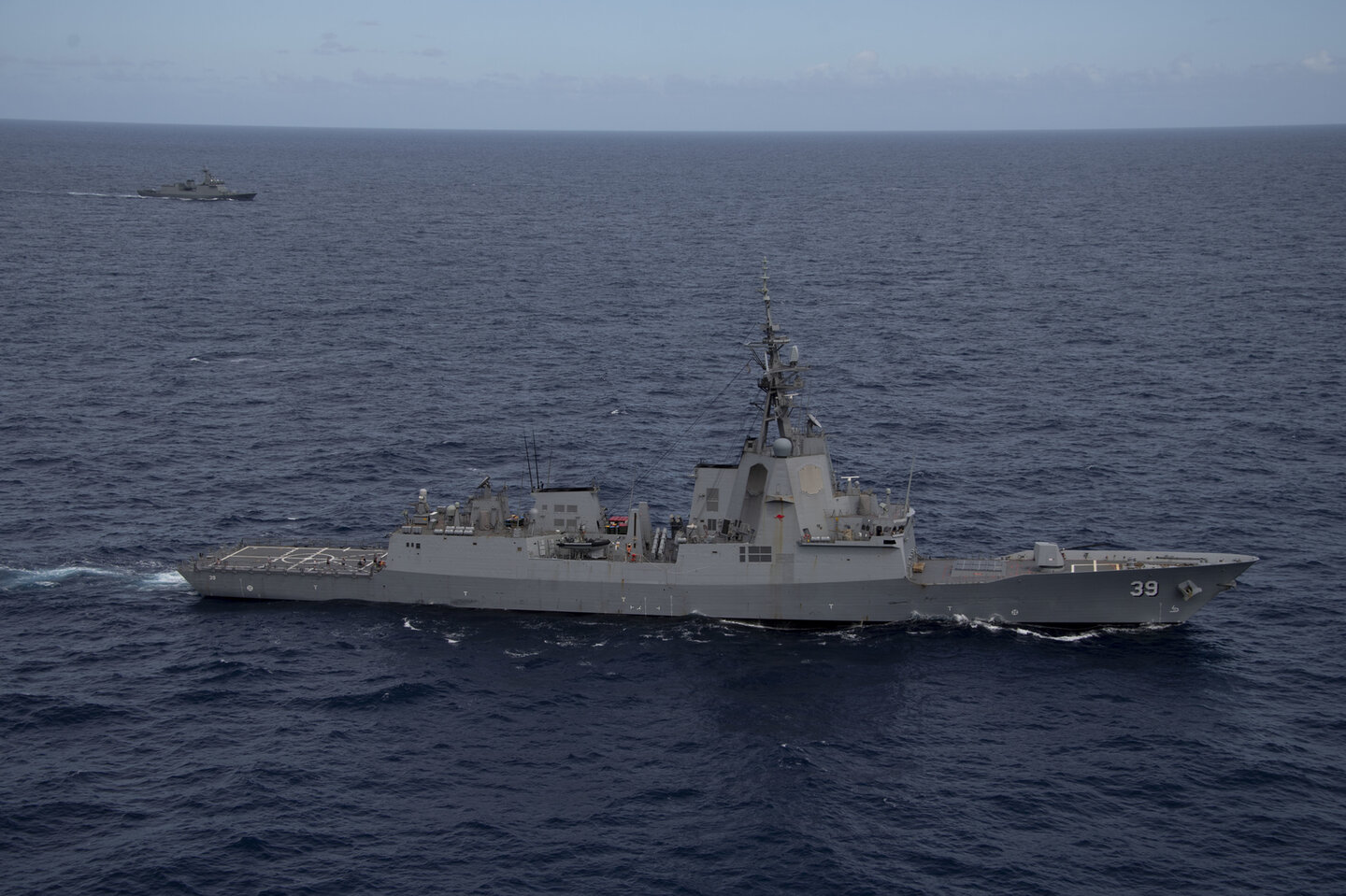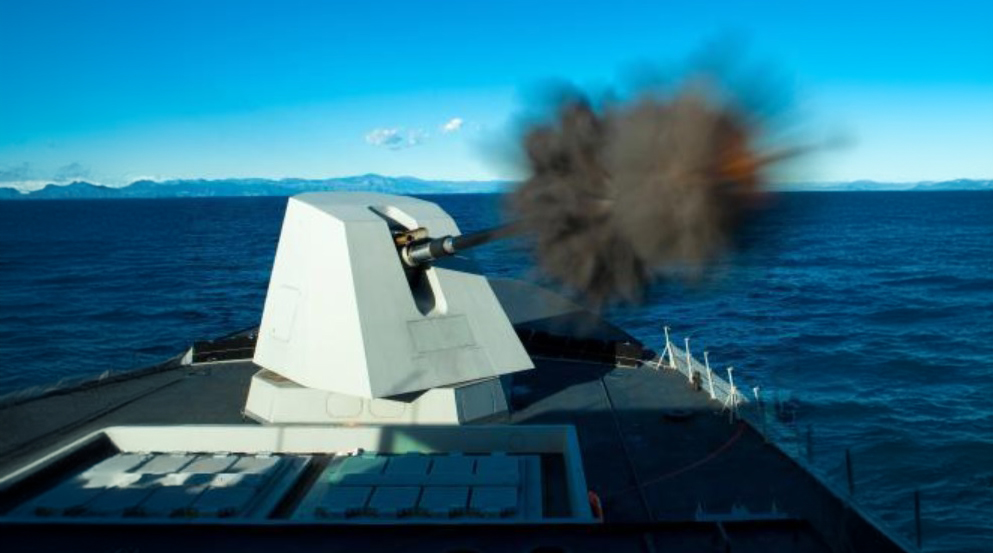Feature
Critical fires: naval main guns maintain relevance
Large calibre main guns remain a vital armament for any frontline ship with the ability to lay down accurate long-range gunfire support. Tim Fish reports.

The Mk 45 127mm main gun is one of the most widely used by Nato and Allied forces. Credit: BAE Systems
The relevance of large calibre naval guns in the missile age continues to persist because although missiles can provide an accurate long-range anti-surface capability, they are also expensive, and ships are limited in the size of their missile inventory.
Meanwhile, gun systems can provide a lethal and accurate defence capability with a high rate of fire and a larger inventory of munitions for sustained operations. Unlike most missiles, naval gun munitions can be replenished whilst at sea without the need for the ship to return to base, meaning the vessel can remain on station for longer.
Recent operations highlight the importance of large calibre naval guns, particularly in closed waters like the Red Sea where there is a growing need for gun systems that are flexible and that can engage targets on land, sea, and air in a crowded maritime environment.
Low-cost uncrewed aerial systems are proliferating in the naval domain and a cost-effective gun system that can lay down defensive fires is more efficient than using multi-million-dollar missiles that are best preserved for use again high-end threats.
Gun systems are becoming more effective again with the use of automated ammunition handling systems (AHS) and precision guided munitions (PGMs). The AHS are able to reload gun systems so they can increase the rate of reload and lay down a more effective response to UAS swarm threats.
PGMs increases the precision of naval rounds meaning fewer are needed to hit a target further improve the cost-effectiveness of using large calibre weapons as main gun. These factors make naval gun systems a critical part of a warship’s arsenal.
Today’s main gun systems usually fire 127mm (5 inch) or 76mm (3 inch) rounds, with one of the most widely used being the Mk 45 127mm naval gun from BAE Systems.
Take your Mark (45)
Tate Westbook, business development director, Naval Guns and Missile Launchers, told Global Defence Technology that the latest Mk45 Mod 4 configuration, which has been available since 2000, include upgrades that enable the weapon to fire any 5-inch munition farther and fire PGMs at land, surface, and air threats.
“These upgrades include a 62-caliber barrel [earlier Mk 45 variants had a shorter 54 caliber barrel], strengthened gun mount and an advanced control system that allows engagement of a wide-range of threats, including small drones,” Westbrook explained.
“In addition, we’ve also integrated the Mk 45 with an automated ammunition handling system, which resupplies the gun while firing and increases the sustained rate of fire, while increasing sailor safety by removing them from the loading sequence. The AHS requires zero manning during operation and automates the process of stowage of rounds during replenishment operations.”
The Mk 45 is used by navies around the world and is one of the most widely proliferated types available, particularly among Western and Allied navies. Earlier variants of the Mk 45 are fitted on about 250 warships worldwide.

The Royal Australian Navy’s Hobart-class destroyers utilise the Mk 45 Mod 4 main gun system. Credit: US DoD
The Japan Maritime Self-Defense Force uses the weapon on four classes of destroyer and its new Mogami-class frigate. The Republic of Korea Navy is also using it on two of its destroyers and frigates and the US Navy has the Mod 4 on its Arleigh Burke-class destroyers from DDG81 onwards. The Mk 45 Mod 4 gun is also used by the Royal Australian Navy’s (RAN) Anzac-class frigates and Hobart-class air defence destroyers.
In addition, the UK Royal Navy is transitioning to the Mk45 Mod 4 gun after having used the 4.5-inch (113mm) Mk 8 gun for decades but is no longer considered adequate.
Among new ship programmes to receive the Mk 45 Mod 4 include the RAN’s new Hunter-class frigates and the UK RN’s Type 26 frigates as well as Turkey’s new TF2000 frigates. The RAN selected the Mk 45 in November 2023 and a contract worth $255m was signed in January 2024.
Leonardo extends the range
The other main large calibre naval gun system dominating the market is the 127mm 127/64 Light Weight (LW) and the 76mm 76/62 Super Rapido main guns from European defence company Leonardo.
The 127mm gun is also known as the Vulcano system as it can fire the latest Vulcano ammunition which offers a ballistic extended range (BER) round or a guided long-range (GLR) round capability.
The Egyptian, Algerian, German, Italian, Netherlands navies use the LW gun, and it has also been selected for the Spanish Navy’s F-110 frigates and the Royal Canadian Navy’s new Canadian Surface Combatant, based on the Type 26. This is a departure from the RAN’s Hunter-class and UK RN’s Type 26 frigates, which use the Mk 45.
Improvements in ammunition are the main way in which large calibre gun systems are enhancing capabilities. The BER uses a multipurpose fuse that means an operate can select the kind of explosive effect required out to ranges of 60km.
Meanwhile the GLR round is fitted with a GPS/IMU, canards and a RF fuse to more accurately hit targets out to 100km with options including height of burst, infra-red and semi-active laser seekers for the round if required.
Vulcano munitions are also being developed for its 76mm Super Rapido gun that smaller ships with this weapon can employ enhanced capabilities. Vulcano rounds have also been tested in the Mk 45 gun.

European defence prime Leonardo also offers a 127mm naval main gun system, which is operated by a range of navies. Credit: Leonardo
BAE System is also developing its own new ammunition capabilities for extended range and precision guidance that do not require modifications to the Mk 45 gun.
“One example is our Hypervelocity Projectile, which has demonstrated its viability for counter-UAS, missile defense, and extremely long-range precision fires from a variety of gun systems, including the US Navy’s 5-inch Mk 45 gun and the US Army’s 155mm artillery,” Westbrook said.
“Its maneuverability, paired with its high velocity and ability for precision guidance, allows it to engage air threats with minimum response time. With new low-cost air threats that are deployed in swarms, this munition provides an advance layer of protection for the surface fleet.”
The HVP project is part of the US Navy’s Gun Launched Guided Projectile effort and whilst it has received funding and has been test-fired on warships as far back as RIMPAC 2018 there is no clear procurement strategy.
As new threats at sea emerge and the focus is on increased operations in the littoral zones the need for warships to have a large-calibre naval gun capability remains critical.
The development of new advanced ammunition types will give naval guns more flexibility to engage targets across the domains providing a cost-effective and sustained capability that cannot be matched my missiles.
What we’re seeing more is space becoming a warfighting domain
Martin Rowse, campaign director of the Skynet programme at Airbus
Caption. Credit:

Phillip Day. Credit: Scotgold Resources
Total annual production
Australia could be one of the main beneficiaries of this dramatic increase in demand, where private companies and local governments alike are eager to expand the country’s nascent rare earths production. In 2021, Australia produced the fourth-most rare earths in the world. It’s total annual production of 19,958 tonnes remains significantly less than the mammoth 152,407 tonnes produced by China, but a dramatic improvement over the 1,995 tonnes produced domestically in 2011.
The dominance of China in the rare earths space has also encouraged other countries, notably the US, to look further afield for rare earth deposits to diversify their supply of the increasingly vital minerals. With the US eager to ringfence rare earth production within its allies as part of the Inflation Reduction Act, including potentially allowing the Department of Defense to invest in Australian rare earths, there could be an unexpected windfall for Australian rare earths producers.
